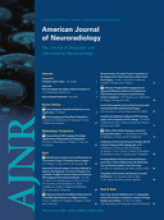Abstract
BACKGROUND AND PURPOSE: CT perfusion (CTP) mapping has been reported to be useful in the differentiation of the infarct core and ischemic penumbra. However, the value of the CTP source imaging (CTP-SI) during the arterial and venous phases has not been fully investigated. The purpose of this study was to develop a CTP-SI methodology for acute ischemic stroke and compare its efficacy with cerebral blood flow (CBF) and cerebral blood volume (CBV) in predicting infarct core and penumbra.
MATERIALS AND METHODS: CT examinations, including non-contrast-enhanced CT, CTP, and CT angiography (CTA), were performed in 42 patients with symptoms of stroke for <9 hours. The Alberta Stroke Program Early CT Score (ASPECTS) was analyzed on the arterial phase CTP-SI and venous phase CTP-SI and then compared with the ASPECTS on CBF and CBV for efficacy assessment.
RESULTS: The ASPECTS on the arterial phase CTP-SI was closely correlated with the ASPECTS on CBF, the Pearson correlation coefficient was 0.88 (P < .001), and the concordance correlation coefficient was 0.7603 (95% confidence interval [CI], 0.6331–0.8476). The ASPECTS on the venous phase CTP-SI revealed a significant correlation with the ASPECTS on CBV, the Pearson correlation coefficient was 0.92 (P < .001), and the concordance correlation coefficient was 0.8880 (95% CI, 0.8148–0.9334). Significant differences were shown between the arterial phase CTP-SI/ venous phase CTP-SI (P < .001) and CBF/CBV (P < .001).
CONCLUSIONS: This study provides preliminary evidence that the arterial phase and venous phase CTP-SI mismatch model could possibly be applied to ischemic regions in the acute stage of stroke to determine penumbra and infarct core.
- Copyright © American Society of Neuroradiology
Indicates open access to non-subscribers at www.ajnr.org












